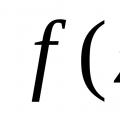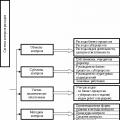Among the most popular in Lately species cable products
can be called VVG cable and its modifications.
VVG denotes a power cable with TPG insulation made of PVC, a sheath (cambric) made of PVC, copper core material, which does not have external protection (Fig. 1).
Rice. 1. VVG cable
Used for transmission and distribution electric current, operating voltage - 660-1000 V, frequency - 50 Hz. The number of cores can vary from 1 to 5. Cross-section - from 1.5 to 240 mm2. In domestic conditions, a cable with a cross-section of 1.5-6 mm2 is used; in the construction of a private house, a cable with a cross-section of up to 16 mm2 is used. The cores can be either single- or multi-wire (Fig. 2). There are no restrictions - you can also install a cable with a cross-section of 10 mm2 in an apartment.

Rice. 2. VVG cable cross-section
Can be used over a wide temperature range: from -50 to + 50 °C. Withstands humidity up to 98% at temperatures up to +40 °C. The cable is strong enough to withstand tearing and bending, and is resistant to aggressive chemicals. When installing, remember that each cable or wire has a certain bending radius. This means that for a rotation of 90 °C in the case of VVG, the bending radius must be at least 10 diameters of the cable section. In the case of a flat cable or wire, the width of the plane is considered.
The outer shell is usually black, although sometimes white can be found. Does not spread fire. TPG insulation is marked in various colors: blue, yellow-green, brown, white with a blue stripe, red and black. The cable is packaged in coils of 100 and 200 m. Sometimes other sizes are also found.
Varieties of VVG:
AVVG- the same characteristics, only instead of a copper core, aluminum is used (Fig. 3);

Rice. 3. AVVG cable
VVGng- cambric with increased non-flammability (Fig. 4);
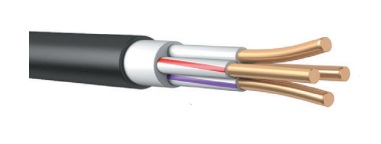
Rice. 4. Cable VVGng LS
VVGp- the most common type, the cable cross-section is not round, but flat;
VVGz- the space between the TPG insulation and the cambric is filled with PVC strands or a rubber mixture.
NYM power cable does not have Russian decryption letter designation. This is a copper power cable with TPZh PVC insulation, the outer sheath is made of non-flammable PVC. Between the layers of insulation there is a filler in the form of coated rubber, which gives the cable increased strength and heat resistance. The cores are multi-wire, always copper (Fig. 5).

Rice. 5. NYM cable: 1 - copper core; 2 - PVC shell; 3 - longitudinal non-flammable sealing; 4 - PVC insulation
Number of cores - from 2 to 5, cross-section - from 1.5 to 16 mm2. Designed for carrying out lighting and power networks with a voltage of 660 V. It has high moisture and heat resistance. Can be used for outdoor installation. Operating temperature range - from -40 to +70 °C.
Disadvantage: does not withstand sunlight well, so the cable must be covered. Compared to VVG of any type, it is more durable and easy to use. However, it only comes with a round cross-section (it is inconvenient to install in plaster or concrete) and is significantly more expensive than VVG. Bending radius - 4 cable cross-section diameters.
It is explained very simply - the cable is flexible. This is a conductor with an operating alternating voltage of up to 660 V, a frequency of up to 400 Hz, or a direct voltage of 1000 V (Fig. 6).

Rice. 6. KG cable
Copper conductors, flexible or highly flexible. Their number varies from 1 to 6. TPG insulation is rubber, the outer shell is made of the same material. Operating temperature range - from -60 to +50 °C. The cable is mainly used to connect various portable devices. Most often these are welding machines, generators, heat guns, etc.
There is a type of KGng with non-combustible insulation.
KG has proven itself excellently as a cable that operates under almost any outdoor conditions. At a construction site, it is simply irreplaceable for pulling power lines. Although some original people, attracted by the flexibility and reliability of the KG, install it as home wiring.
Cable VBBShv- armored power cable with copper conductors (Fig. 7).
Rice. 7. Cable VBBShv
The latter can be either single-wire or multi-wire. Number of cores - from 1 to 5. Section - from 1.5 mm2 to 240 mm2. TPG insulation, outer shell, space between the insulation and the cambric - PVC is used in all these places. Then comes the armor of two tapes, wound in such a way that the outer one overlaps the boundaries of the turns of the lower one. On top of the armor, the cable is enclosed in a protective PVC hose, and the VBBShvng modification uses this material of reduced flammability.
VBBSHv designed for alternating rated voltages of 660 and 1000 V. Single-core modifications are used to conduct direct current. Installed in pipes, ground and outdoors with protection from the sun. Operating temperature range - from -50 to +50 °C. Moisture-resistant: at a temperature of +35 °C it can withstand 98% humidity. It is used when conducting electricity for stationary installations, as well as supplying electricity to detached objects. Bending radius is at least 10 cable cross-section diameters. VBBSHv is perfect for underground supply of electricity to a separate building.
Modifications:
AVBBSHv- cable with aluminum core;
VBBShvng- non-flammable cable;
VBBShvng-LS- non-flammable cable with low gas and smoke emission at elevated temperatures.
The transmission and distribution of electrical energy is impossible without wires and cables. In addition, wires are also used to assemble control, protection and automation circuits. Let's look at how they differ and are classified depending on their design and purpose.
Wire classification
The first classification feature by which wires are distinguished is core material. They come in copper and aluminum. In addition, copper wires are either rigid or flexible. The hard core has a solid, round cross-section. Starting from a certain cross-section, rigid conductors are made from round wires. This is due to the fact that it is impossible to bend a core of such a cross-section during installation.
Highly flexible wires consist of thin copper wires gathered into a bundle. Their advantage is that they can be tightly packed in a cable channel or collected in a bundle. In addition, they are convenient to use for connecting elements located on cabinet doors or control panels. Connecting flexible conductors to the terminals of electrical equipment is possible only with the use of special tips. Although some of the devices support direct connection of flexible wires, the use of ferrules allows you to disconnect and reconnect them with maximum convenience. In addition, during assembly there is no need to ensure that none of the wires falls out of the bundle and is not shorted to an adjacent terminal.

Aluminum conductors are not made flexible due to the excessive brittleness of aluminum. For the same reasons, wires with a cross-section below 1 mm 2 are not produced.
Further differences relate to the insulation material covering the live parts.
In addition, the wires are made multi-core. In this case, their characteristics include the number of cores (two, three or four) and the material of the shell covering the structure. The sheath may be absent, as in a wire, commonly called “noodles”. This category also includes cords that are characterized by increased flexibility of both core material and insulation and are intended for connecting portable electrical receivers and household appliances.
All listed parameters are indicated in the wire type. It is built according to the principle shown in the figure.
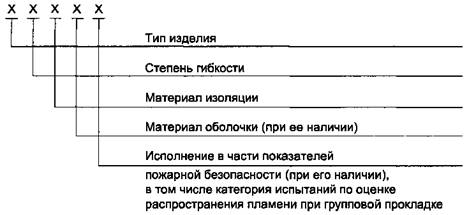
Labeling begins with an indication core material. For copper, this element is skipped, and for aluminum, the letter “A” is placed at the beginning of the code.
The product type may contain letters deciphered in the table.
|
Letter "product type" |
Decoding |
| P | the wire |
| installation wire | |
| PB | household wire |
| Sh | cord |
The most common insulation materials: polyvinyl chloride (B) and rubber (R). The same applies to the shell material.
Some manufacturers deviate from generally accepted labeling rules. For example, a wire with a single core in vinyl insulation is sometimes designated as PV-1, and flexible - PV-3.
Cable classification
Cables differ in the material of the current-carrying cores. Copper is an expensive material, so sometimes cables with aluminum conductors are deliberately used to reduce costs. The disadvantage of this method is the increase in the cross-section of the conductors, since aluminum has lower electrical conductivity compared to copper. In addition, it oxidizes more intensively and is softer, which leads to the need to stabilize bolted connections, otherwise the contacts will weaken over time. Due to the risk of creating a galvanic couple between copper and aluminum, connection to copper terminals of electrical devices is possible only with the use of special lubricants. Manufacturers of modern electrical equipment, in order to ensure the ability to connect cores made of various materials to it, make contact pads anodized or tinned.
Cables, like wires, are available with flexible cores and monocore. To save space inside the cable, large cross-section cores are made in sectors. The sector cores themselves are monolithic or consist of a group of wires tightly laid side by side.

The use of cables and wires with aluminum conductors with a cross-section below 16 mm 2 for the installation of electrical wiring in household facilities is prohibited by the PUE.
The cable cores have insulation that completely follows their shape. The most common material from which core insulation is made is polyvinyl chloride(PVC), called vinyl for short. Cables with insulation from rubber. They have great flexibility and are used in devices whose cables move during operation. They are used to power and control crane beams, connect grab, gantry and bridge cranes. Rubber in the open air becomes woody, cracks and breaks. It dries even under the influence elevated temperature. Therefore, the insulation of rubber cores after cutting the cable is additionally protected by installing PVC or heat-shrinkable tubes.
Previously, they were used in electrical installations cables with impregnated paper insulation. Special cable paper is wound onto the cores in several layers and then impregnated with a special compound. These cables were intended for use in electrical installations up to and above 1000 V, but had a number of disadvantages. The mass with which the cables were impregnated came out through the cracks in the end couplings and holes that appeared as a result of damage to the cables, and moisture from the air or ground took its place. As a result, the insulation deteriorated and the cable failed.
In addition, the implementation of connecting and end couplings on these lines took a long time and required the professionalism of workers.

These cables are being replaced by products made from cross-linked polyethylene. They do not have the main disadvantages of oil-impregnated cables, and the technology for installing couplings on them is much simpler.

The cable minimally includes at least one common sheath for the cores - waist insulation. It is usually made from the same material as the core insulation. It can be wound over it armor made of steel or galvanized tapes, and then another insulating shell. The cable armor must be connected to the ground loop.
It is worth highlighting control cables. If power cables include from three to five cores, and their cross-section varies from 1.5 to 240 mm 2, then the number of cores in the control cable is measured in tens. The range of their sections is not wide: from 1.0 to 4.0 mm 2.

They are also sometimes equipped with an analogue of armor - screen, consisting either of woven thin copper wires (like antenna cables old model), or from copper or aluminum tapes. The need for screens is dictated by the development of microprocessor devices in control circuits that are sensitive to electromagnetic interference. The cable shields are connected to the PE bus, usually only on one side.
Cable markings
A letter code is used to mark cables. It indicates full information about the materials from which the cable is made, its purpose and design. From the markings you can find out exactly what shells, screens or armor are contained inside the product. The order in which information is decrypted is shown in the table.
| Purpose | Examples | |
| Core material | no letter | Copper |
| A | Aluminum | |
| Additional metal shell | A | Aluminum |
| WITH | Lead | |
| Purpose | TO | Control |
| Core insulation material | IN | Polyvinyl chloride |
| R | Rubber | |
| HP | ||
| Shell material | IN | Polyvinyl chloride |
| R | Rubber | |
| HP | Flame retardant rubber | |
| Availability of reservation | B | Two layers of tapes |
| Bn | The tapes have a protective non-flammable sheath | |
| No protective cover | G | "naked" |
Cables with cross-linked polyethylene insulation are marked according to special rules.
For each type of wiring it is necessary to select the correct wire. When choosing a wire, you need to take into account such points as the purpose of its use, the type of sheath, as well as the strength of the current that it will conduct. The current strength is directly proportional to the thickness of the wire.
Single-core and stranded wires
The wire diameter is classified by gauge. In this case, the quantities are inversely proportional, i.e. The smaller the cable gauge number, respectively, the larger the core diameter. The larger the gauge of the wire, the greater the number of cores in it. This makes multi-core wires easier to bend and therefore easier to install.
Types of stranded wires. Cables for connecting home electrical wiring and the main grounding line.

Single-core and stranded wires.

The most common single- and multi-core wires and their load limits.
In a residential building, as a rule, electrical wiring with non-metallic insulation is used. This wire contains two conductors in a plastic insulating winding and one grounding conductor. All these wires are placed in a plastic sheath.
These parameters are easily read in the name of the wire itself.

The main types of wires for electrical wiring:
- two-core wire in a plastic sheath for dry rooms;
- two-core wire with continuous insulation for above-ground structures exposed to moisture;
- two-core wire with continuous insulation for underground structures;
- lamp cord;
- flexible parallel cable.

Types of wires for home electrical wiring.The structure of an industrial cable used in harsh environments, as well as an auxiliary cable. Fiberglass wrapped in paper is used to separate the wires.
Cable structure:
- phase;
- zero;
- Earth;
- paper shell;
- plastic shell.
For example, wire 14-2 has two cores, and if it contains grounding, then the prefix “with grounding” is added to the name. Often, in a residential building, wiring is made of single-core wires (14-10 numbers). The table below lists copper, aluminum, and copper-clad aluminum wires and the amperage that each can carry.
Types of wires and their electrical current carrying capacity.
| Amps | ||
| Wire size | Copper Wire Size | Size of aluminum wire or the same wire covered with copper |
| 18 | 7 | |
| 16 | 10 | |
| 14 | 15 | |
| 12 | 20 | 15 |
| 10 | 30 | 25 |
| 8 | 40 | 30 |
| 6 | 55 | 40 |
| 4 | 70 | 55 |
| 3 | 80 | 65 |
| 2 | 95 | 75 |
| 1 | 110 | 85 |
| 0 | 125 | 100 |
Types of Electrical Cables
The following types of wires are used in wiring:
- NM – for dry environment;
- NMC – is used at high external humidity, usually in above-ground structures;
- UF - waterproof wire is used in underground structures.

Some popular types of electrical cables include armored and waterproof.
Quite often a flexible double wire and a lamp cord are used. The lamp cord has two cores, which are in one plastic sheath, and also has a small diameter. The gauge of this cord can be from 18 to 10. This cord belongs to class C. The marked lamp cord has grooves or ribs on the side where the phase is located.

Photo of a regular lamp cord.
Among other wires, flexible double wire is quite common for lamps, refrigerators, radios, etc. This type of wire is classified into types such as SP, SPE and SPT, as well as by number and type of outer sheath. SP and SPT have a heat-curing plastic sheath, while SPE type wire has a heat-curing elastomer sheath.
Wire diameters
Each type varies in wire diameter. So, for example, the SP-1 wire has 18 or 20 gauge wire, and the SP-2 has 16 or 18 gauge wire. Three-core wires have 18 to 10 gauge wires. Since the gauge of three-wire wires is generally lower, they are used for electrical appliances such as room air conditioners or refrigerators.

Three-core cable alternating current SP-8.1 made of pure oxygen-free copper.
Heavy-duty cord is used for using power tools. This type of cable has three stranded wires, which are insulated with plastic and housed in a durable plastic sheath. These wires are separated by several layers of fiberglass, which is wrapped in insulating paper. Such cables are marked SE, SEO, SEOW and SEOO. The suffix SJ denotes auxiliary cables. A cord intended for a computer, for example, is branded SJT.

An example of a protected SEOW brand electrical cable from Coleman Cable.
The most common cables in older homes are BX armored grades. This type of cable consists of two insulated wires wrapped in paper and a bare ground wire in a flexible metal sheath. Today, such cables are used in places with a high probability of damage and additional protection is required. This cable, compared to “plastic” cables, is less easy to cut and strip and is more difficult to connect.

Wiring protected metal pipe and armored cable type AC. Elements:
- spring flexible steel shell;
- ground, phase, zero;
- paper insulation;
- rigid metal pipe.
There are also plastic armored cables.
The protective casing for electrical wiring is rigid metal or plastic pipe, in which the wires are laid. The pipe itself is just a cover. As a rule, the pipe is installed first and only then the wires are pulled through it.
Typically, a protective pipe is installed in areas where serious protection from external influences, such as moisture and possible damage, is required. A striking example of the use of a protective casing (pipe) can be the path from the input to the meter.

Plastic casing with metal braiding that protects electrical cables.
If necessary, the pipe can be connected with threaded couplings and bends at turns. If the pipe walls are thin enough, it can be bent at a large angle. Electrical codes define acceptable bending angles.
Aluminum wires
Aluminum wires were used in some houses built back in the 40s. last century. An aluminum wire should be twice as thick as a copper wire (at the same current strength), since aluminum has greater property electrical resistance than copper. When selecting the gauge of aluminum wire, it is always recommended that you refer to your local code. You need to find out whether your sockets and switches can be used with aluminum wiring.
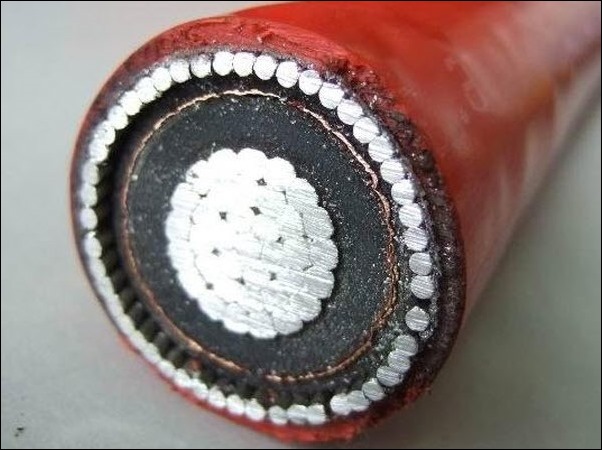
Aluminum insulated XLPE power cable.
In aluminum wire wiring, screw connections are used rather than clamping ones. Lamps, sockets and other electrical fittings can be used with aluminum wiring, provided they do not have special markings such as “CO/ALR”. If the socket or switch heats up, the lights flicker, you smell burnt insulation, or other bad signs, call an electrician immediately, as serious troubles may await you.
Aluminum electrical wiring can fail without such obvious signs. Don’t even think about doing it yourself and trying to repair the electrical wiring yourself.

Aluminum electrical cables AI ACSR in a protective sheath of neoprene.
In order to determine what metal your electrical wiring is made of, you need to look at the exposed section of the wire. It can be found either in the attic or basement. As a last resort, open a small section of the wiring yourself. After a certain distance, the aluminum wire is marked “AL” or “Aluminum”.
Try whenever possible to replace aluminum wiring with copper, as only a professional can save it. After all, only he knows what types of connections are used in certain cases. Just make sure the professional is sober.
How to work with wires correctly
Before connecting the wire, you need to measure the required length, cut and strip the insulation from the end of the wire. Several types of tools are used for this work.

Tools you can’t do without when doing electrical work:
- long-nose pliers, also known as round-nose pliers;
- regular pliers;
- wire cutters
When purchasing such a tool, make sure that its handles are insulated as required, otherwise you will physically not be able to return the product later.

Photo of a tool for stripping electrical wire from insulation.
Pliers are very convenient for working with large wires such as the Romex cable. Round-nose pliers (also known as long-nose pliers) have small nippers and are useful for rolling the bare end into a ring. With wire cutters you can cut small diameter wires even in the most difficult to reach places, which is undoubtedly an advantage over other tools. However, the title of universal and perhaps most useful tool goes to the insulation stripper.
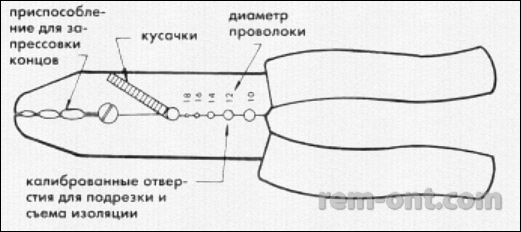
Typical insulation stripper. Components:
- openings for pressing ends;
- wire cutters;
- you can choose the wire diameter;
- calibrated holes for trimming and removing insulation.
They can determine the gauge of the wire, remove the insulation, press the ends together, make a ring at the end, and many other useful things. In general, the tool is suitable for both inexperienced housewives and professional electricians.
Cutting ends
In order to connect a wire to a fitting or to another wire (twist), you must first expose its end by removing the insulation. Use special tools for this purpose, since there are a great many of them. During work, do not cut the wire under any circumstances, otherwise you will significantly reduce its strength and current carrying capacity, since the cross-section will decrease. When working with multi-core wire, it is necessary that all the wires remain intact and unharmed.

With the help of a specialized stripper, insulation can be removed in a matter of seconds.
When working with a cable in plastic protection, the first thing you need to do is expose the core wires by cutting off the sheath from it. For this purpose, use a sharp knife. With the cable on a hard surface, make a cut at the end along it to the length you want to expose. Try not to damage the insulating sheath of the core wires. If you still make such a mistake, cut off the damaged piece of cable completely and start the operation again.

Removing the sheath from the cable.
- Place the cable on a hard surface and carefully cut the sheath down the center.
- Pull aside and cut off the sheath without damaging the wires.
Essential elements:
- plastic sheathed cable;
- ordinary tool knife;
- plastic shell;
- Use a knife or scissors to cut the shell.
When removing insulation from a core wire, you can use a pocket knife. Make careful cuts without touching the wire itself, and begin to cut the insulating sheath with smooth movements away from you so that the result is a cone. Do not attempt to cut perpendicular to the wire as you may damage the integrity of the metal core (wire).

Examples of how to correctly and incorrectly remove insulation from a conductor.
- You need to be very careful when removing the insulation with a knife.
- See how to remove it correctly.
- You cannot cut the insulation perpendicularly in copper wire - you risk cutting it.
- If the wire is cut, its transmission capacity will decrease significantly.
The insulation can also be removed using a miracle stripper. To do this, determine a calibrated hole on the tool that corresponds to the diameter of the wire, place the wire in this very hole, clamp it and make a 360-degree turn (not Celsius) around the wire with the puller. Having thus cut off the insulation, pull it off the wire.

Removing insulation using a universal stripper.
- Place the wire in a hole of suitable diameter.
- Squeeze the handles and wrap the puller 360 degrees around the wire.
- The stripper cuts the insulation and preserves the wire itself.
Connecting the wire to the fittings
To connect a wire to an electrical fixture, you need to clamp it with a screw or insert it into a clamping contact. In the case of a screw, the following procedure must be followed.
First, strip the insulation from the end of the wire, three-quarters of the way around the circumference of the screw. Then twist the bare end of the wire into a loop using round-nose pliers (also known as long-nose pliers). And finally, put the loop you made on the screw so that when screwed clockwise, the wire wraps around it.
![]()
Make a loop three-quarters of the way around the screw.

Place the loop on the threaded surface of the screw, with the free part of the loop facing clockwise in the direction of tightening.

Tighten the screw so that the side of the hinge is in contact with the plane of the plate.
If you need to connect a wire to an electrical fixture using a clamp terminal, proceed as follows. Strip the end (of course the wire) to the length of the gauge, which is usually indicated on the side of the fittings, and insert it into the hole in the clamping contact.
![]()
Connecting the wire to the clamp contact.
- Insert the bare end into the hole.
- Press to pull the end out.
- Insert the end of the screwdriver to open the clamp.
- In this case, the end of the wire must be cleared of insulation in advance.
The end will clamp automatically in this hole. If you suddenly need to release the clamped end, insert a screwdriver into the slot located near the hole. On the reverse side of the switch there is such a thing as a groove-caliber. It shows the required length of the bare end, which is inserted into the clamp.
Video on connecting wires in a junction box
This video demonstrates visual techniques for connecting drives in a distribution box and demonstrates how disconnection and welding of various twisted electrical wiring is carried out.
Twisting wires
Twist the ends of the wire, first exposing them to a length of about 16 mm. Then place a special cap on the twisted ends, rotating it in the same direction along which the exposed wires were twisted. If the cap does not completely cover the exposed wires, trim them so that it does.

An example of twisting a three-core cable.

Specialized pliers for twisting wires.
For reliability, you can additionally wrap insulating tape the junction of the cap with the wires, thus better securing it. It is advisable not to spare the tape and cover the joint with two layers.

Twisting the wires and covering them with a cap.
- Place the ends of the wires against each other and twist clockwise.
- Place the cap on the twist and turn it clockwise.
- Secure the cap to the wires with several layers of insulating tape.
In exactly the same way, stranded and solid wires are connected.

Classic multi-core cable with copper braiding and plastic protective sheath.
However, stranded wires with a small diameter cannot be connected by twisting. As a rule, these are lamp cords and cords of low-power consumers. Such cords must remain intact and if this integrity is damaged, the entire cord must be replaced.
Today there are a large number of different cables on the market that have different purposes. There are many categories into which they can be classified:
- material
- purpose
- design
- number of cores
- presence and type of insulation
- protection
Classification of cable types by material
Based on the type of material from which the conductors are made, the most commonly used aluminum and copper wires can be distinguished. Other metals are also used, but they are not widely used. Separately, we should highlight the category of fiber-optic information cables, which do not contain metal conductors.
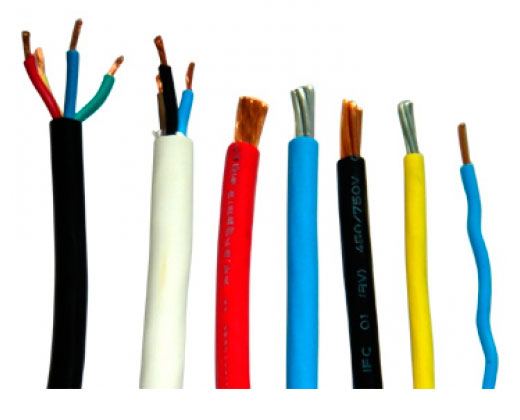
Classification by purpose
According to their purpose, cables can be divided into power and information. The former are used to supply power voltage to electrical appliances. The second category is used for transmitting information signals (telephone, alarm, Internet, antenna connection).

Design and number of cores
There are single-core and multi-core cables. A multicore cable consists of conductors connected in parallel and insulated from each other. The cores may consist of one or more wires. Flexible wires are usually made of stranded conductor.

Availability and type of insulation
There are both bare wires (used for installation of external electrical networks) and those covered with insulation. Insulated cables, in turn, can have single-layer or multi-layer insulation. In the first case, each core has only one layer of its own coating; in the second, there can be several layers of individual insulation; in addition, they can be enclosed in a common shell.

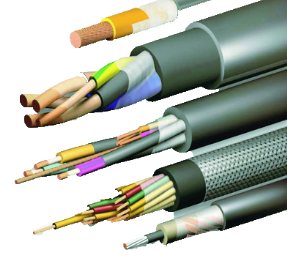
Classification of cable types by type and presence of protection
There are shielded and unshielded cables. The presence of screens protects the cable or the environment from electromagnetic radiation. They (screens) are made, as a rule, in the form of a coating of foil or multi-wire braiding applied over the core insulation.
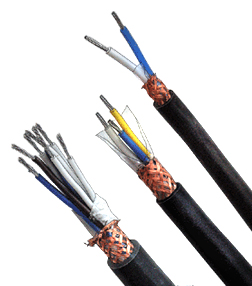
In addition to electromagnetic protection, there is also fire protection, which ensures the product’s resistance to overheating. Unprotected cables, as a rule, can withstand temperatures up to 100 degrees Celsius; fire-resistant cables can withstand short-term overheating up to 400.
Marking different types of cable
The most voluminous category for classification. Letters and numbers in the name, incomprehensible at first glance for a person without special education, most fully reflect information about the cable. They allow you to obtain information about the type, material, protection, and functional purpose of the product.
Here is a breakdown of some letters in the cable names, according to domestic GOST:
A - means the core material is aluminum. If the letter is missing, the cable is copper.
AC - aluminum conductor with lead sheath.
AA - aluminum conductor, the cable has an additional aluminum sheath.
B - denotes an armored cable having a two-layer steel sheath.
B - cable insulation is made of PVC. If there are two letters B (first and second or second and third), it means, in addition to insulation, there is an individual sheath of PVC conductors.
Г - the meaning depends on the position of the letter: at the end of the abbreviation it means a “bare” cable (without a protective coating), at the beginning it means the purpose of the wire for the mining industry. A small r indicates cables with an additional waterproof shield coating.
Shv - the cable sheath is made in the form of a PVC hose.
Shp - polyethylene sheath-hose. Shps - polyethylene is self-extinguishing.
K - at the beginning of the abbreviation indicates that the wire is a control wire, at the end - indicates the presence of steel armor made of round wires.
C - lead cable sheath.
O - a separate shell of each core.
R - rubber insulation. NR - insulation made of non-flammable rubber.
Ng-cable is fire-resistant and does not support combustion.
LS and HF at the end - indicate low smoke and gas emission, respectively, during fire.
The numbers in the name indicate the number of cores in the cable and their cross-sectional area.
Examples:
1. VVGng-LS 4x2.5. Power cable with polyvinyl chloride (first B) insulation, with a polyvinyl chloride individual sheath of cores (second B). There is no protective coating (the letter G indicates a “bare” cable), but there is fire protection (ng at the end), and during the combustion process the wire does not emit smoke (LS). The cable has 4 copper (there is no letter A in the name) conductors, with a cross-section of 2.5 mm2. A similar aluminum wire would be marked AVVGng 4x2.5.

2. VBShv 4x16. Copper (no letter A) wire, in PVC insulation (letter B), with steel armor (B), in a protective hose made of polyvinyl chloride (Shv). Consists of 4 cores, each with a cross-section of 16 mm2. The non-flammable modification is designated AVBShv-ng.

The color marking of the core shells is also important. For the purpose of unification and ease of installation, the standard provides the following color codes for conductors:
Light blue or blue - neutral conductor (neutral)
Yellow-green (striped) - ground line.
Yellow-green with blue - neutral conductor combined with ground.
Black, brown, orange, red and others are current-carrying conductors.


